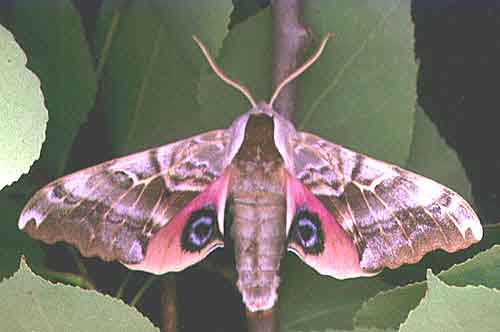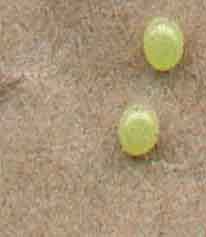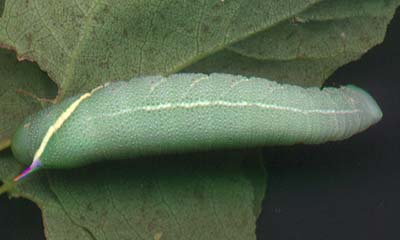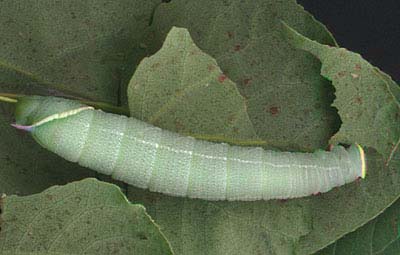THE SMERINTHUS CERISYI MOTH,
CERISYI'S SPHINX


This site has been created by
Bill Oehlke at oehlkew@islandtelecom.com
Comments, suggestions and/or additional information are welcomed by Bill.
TAXONOMY:Family: Sphingidae |
MIDI MUSICcopyright C. Odenkirk ON.OFF |
Above image is posed: Smerinthus cerisyi antennae typically rest alongside head and thorax and forewings generally conceal hindwings.
Reared stock, stored in refrigerator at 48 F from October until May, began eclosing nine days out of storage at 68 F.
Moths eclose after dark, usually around midnight.
Females, with a body girth much greater than that of males, will mate the same night as they have eclosed.
Resting males arch the lower third of their abdomens upwards towards the thorax while females rest with the abdomen uncurled.
Both sexes rest with wings parallel to the resting surface.
Females have a relatively short tongue length of 5 mm and readily deposit all their eggs (100+) on the insides of brown paper grocery bags or sandwich bags within 5 or 6 days without any feeding. Spherical, pale green eggs are difficult to distinguish from other Sphingidae eggs. |  |
 | Larval growth is rapid (3-4 weeks) on either willow or poplar and this species readily pupates under artificial conditions, i.e., dark enclosure, bottom filled with loose tissue or paper towelling. Pupation usually occurs within 4 to 5 days.Scans by Bill Oehlke |
 | Cerisyi larvae greatly resemble modesta larvae, both being pale green, with granular skin, pale lateral diagonal lines, faint red spiracular circles, and very pale longitudinal lines running from the head to a more pronounced anal diagonal line.Modesta have a distinct pink head while cerisyi have green heads bounded dorsally with a pale yellow inverted "V". |
After allowing the eggs a day or two to harden, I gently remove them with my thumbnail to 414 ml (about 1/2 quart or 1/2 liter) ziploc plastic tubs. I use a different tub for each evening's eggs and record date on tub. I put no moisture in with the eggs and snap the lids shut. Larvae usually emerge in the morning 6-8 days after deposition. The eggs can be left affixed to cut outs of brown paper bag. No food is put in tubs until after larvae have begun emerging. (Good idea not to have unhatched eggs in container when inserting food)
A few poplar or willow leaves left affixed to twig are placed in with emerged larvae. After two or three days of feeding, larvae are moved outdoors to sleeved willow or poplar branches. I typically use six-foot-long, frass-slotted Remay sleeves for cerisyi (25 larvae/sleeve). Frass slot is located at lower end of sleeve and fastened shut with a clothespin. The open end of the sleeve is tied shut with some cotton string after I have placed the tiny larvae, still clinging to indoor feeding twig, inside the sleeve. The twig is gently rested on upper foliage inside sleeve. Frass is removed as needed by unclipping clothespin.
When larvae are nearly full grown or begin to leave foliage (3-4 weeks) and crawl around on sleeve, I bring them indoors and put them in 2-5 gallon clear plastic tubs with cut food. These larvae have strong mandibles and desire to leave host to pupate underground is so strong, that they will actually chew holes through Remay cloth if not removed.
When larvae leave food in plastic tubs,I gently lift larvae and place them in lidded buckets that have three or four layers of paper towels on the bottom. Buckets are placed in warm, dark spots, and pupation occurs in 4-5 days under paper towelling.
After pupae have hardened for several days,
I place them side by side on top of a few sheets of folded paper towels in same ziploc containers
I used for eggs. Here on P.E.I. cerisyi seem to have only a single generation. Pupae are stored at
room temperature in lidded containers until they go in fridge in October for winter storage. One
or two drips/drops of water in the container at time of entry to fridge is all the care that is
needed over the winter. I have a separate mini-fridge that I use for Sphingidae pupa storage and keep temp.
there around 40-45.